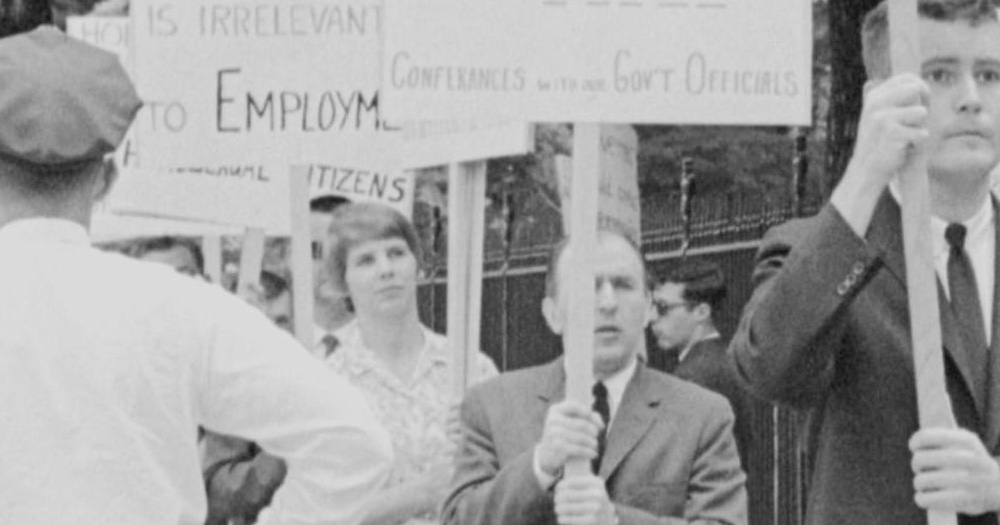American Senator Joseph R. McCarthy didn’t possess much influence at the beginning of his tenure in 1947. That was until 1950 when the politician claimed that he had a list of some 200 Communists that were employed by the US Department of State. From then on, he became a leader against Communism during the Cold War. Known as the time of the “Red Scare”, McCarthy used unqualified methods of investigation to detect communist subversives within the US workforce.
The Red Scare was the promotion of widespread fear of a potential rise of communism and anarchism. Though not reported on as much as the Red Scare, this wouldn’t be the last time that manufactured mass hysteria would be present in the country. Under President Dwight D. Eisenhower in 1952, the persecution and removal of gay men and lesbians from the government’s workforce became known as “The Lavender Scare”.
The time is described by US historian David K. Johnson as “a classic case of scapegoating.” The Executive Order 10450 barred gay and lesbian Americans from employment in the federal government. In the eyes of Eisenhower’s cabinet, gay and lesbian people posed a threat to national security. They believed that these groups were more susceptible to blackmail and generally had weak moral characters.
?️ 1953
✒️ Following the Senate report, Pres. Dwight Eisenhower banned homosexuals from working for the government or its contractors.
? The moral panic around homosexuality, known as the “lavender scare”, was now official policy, leading to mass dismissals of gay people. pic.twitter.com/J92PSYwr87
— Openly ?️? (@Openly) October 5, 2022
During the post-war years, queer culture’s visibility had grown. The opposition to LGBTQ+ freedoms became meshed with fears of potential subversives within the federal government, leading to Executive Order 10450. The unfounded idea of gay and lesbian workers being traitorous allowed many of these people to be investigated by the US state.
Employees were dismissed due to their sexual orientation; many were questioned without an attorney. The sessions of interrogation included scores of pressing questions about the person’s sex life. Many had “voluntarily resigned” after interrogation, with others who tragically died by suicide as a result. Due to the nature of the Lavender Scare, where so many Americans were forced to hide their sexual identity, there is little consensus as to how many people were affected.
In an interview with TIME, David K. Johnson estimated that the number lies somewhere between 5,000 and 10,000. Josh Howard, whose documentary The Lavender Scare chronicled the era, said that “The question of how many people were fired doesn’t even capture the extent to which this affected people’s lives.”
In 1953 the FBI investigated 8 #ManhattanProject women, most of them Women’s Army Corps veterans. The Lavender Scare destroyed careers, ruined lives, and had a lasting effect on LGBTQ+ working in the federal government and serving in the armed forces. #PrideMonth pic.twitter.com/cuMOhCWIvd
— Manhattan Project NHP (@MnhtnProjectNPS) June 29, 2022
One such example of someone who inevitably conquered the Lavender Scare was Helen James, who was arrested and discharged from the United States Air Force in 1955. She was dismissed as “undesirable”, leaving with no severance pay or other military benefits. After she forged a successful career in physical therapy and graduated from Stanford University, she decided to fight her discharge status.
At the age of 90, James sued the US Air Force in order to upgrade her discharge to honourable. The case was ultimately ruled in her favour, and she is now eligible for all veteran benefits. Her story, along with all photos she donated, are available in the National Air and Space Museum Archives in Washington DC.
Helen James was arrested and discharged from the US Air Force in the 1950s as part of the “Lavender Scare,” a campaign to remove LGBTQ people from government employment. Our Archives’s Helen G. James collection tells her story: https://t.co/KFY2RWs4Zo #SmithsonianPride pic.twitter.com/FNN5EIa67Q
— National Air and Space Museum (@airandspace) June 1, 2022
Frank Kameny, who is the centre of Josh Howard’s 2017 documentary, was an astronomer in the US Army. He too was made unemployed by the Lavender Scare but instead devoted his life to the gay rights movement.
In an interview with the Guardian, Howard describes Kameny as “the Rosa Parks of the gay rights movement: a private individual who one day stood up and said, ‘I’m not going to take this anymore.’” He took legal action against the decision to remove him from the workplace. He highlighted discrimination as the real reason for his dismissal, above the theory that he was a national security threat.
The end of the Lavender Scare came at a time accompanied by other advances in the gay rights movement. Just four years before the Stonewall riots, Kameny picketed the White House on the grounds of gay rights. It was bravery and persistence from those like Helen James and Frank Kameny that brought about real progress. The era of the Lavender Scare and the Stonewall Riots was a catalyst for change, facilitated by members of a community that yearned for it.
© 2023 GCN (Gay Community News). All rights reserved.
Support GCN
GCN is a free, vital resource for Ireland’s LGBTQ+ community since 1988.
GCN is a trading name of National LGBT Federation CLG, a registered charity - Charity Number: 20034580.
GCN relies on the generous support of the community and allies to sustain the crucial work that we do. Producing GCN is costly, and, in an industry which has been hugely impacted by rising costs, we need your support to help sustain and grow this vital resource.
Supporting GCN for as little as €1.99 per month will help us continue our work as Ireland’s free, independent LGBTQ+ media.

comments. Please sign in to comment.